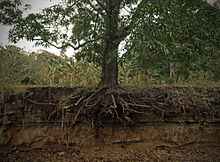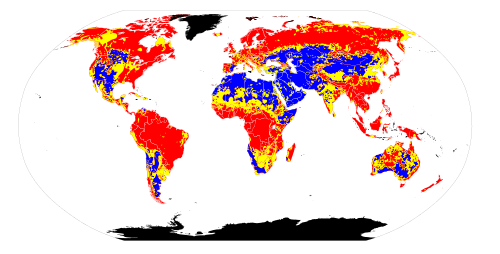Residual sodium carbonate index
The residual sodium carbonate (RSC) index of irrigation water or soil water is used to indicate the alkalinity hazard for soil. The RSC index is used to find the suitability of the water for irrigation in clay soils which have a high cation exchange capacity. When dissolved sodium in comparison with dissolved calcium and magnesium is high in water, clay soil swells or undergoes dispersion which drastically reduces its infiltration capacity.[1]
In the dispersed[clarification needed] soil structure, the plant roots are unable to spread deeper in to the soil due to lack of moisture. However, high RSC index water does not enhance the osmotic pressure to impede the off take of water by the plant roots unlike high salinity water. Clay soils irrigation with high RSC index water leads to fallow alkali soils formation.[2][3][4]

RSC index formula
RSC is expressed in meq/l units. RSC should not be higher than 1 and preferably less than +0.5 for considering the water use for irrigation.[5] The formula for calculating RSC index is:
- RSC index = [HCO3 + CO3] − [Ca + Mg]
- RSC index = HCO3/61 + CO3/30 – Ca/20 – Mg/12 (in case the ionic concentrations are measured in mg/l or ppm as salts)
While calculating RSC index, the water quality present at the root zone of the crop should be considered which would take into account the leaching factor in the field.[6] Calcium present in dissolved form is also influenced by the partial pressure of dissolved CO2 at the plants root zone in the field water.[7]
Natural water contamination

Soda ash [Na2CO3] can be present in natural water from the weathering of basalt which is an igneous rock. Lime [Ca(OH)2] can be present in natural water when rain water comes in contact with calcined minerals such as ash produced from the burning of calcareous coal or lignite in boilers. Anthropogenic use of soda ash also finally adds to the RSC of the river water.
Where the river water and ground water are repeatedly used in the extensively irrigated river basins, the river water available in lower reaches is often rendered not useful in agriculture due to high RSC index or alkalinity.[8] The salinity of water need not be high.
Soft water
Water quality with high RSC index is synonymous with the soft water quality in industrial water treatment terminology.[9] When calcium and magnesium salts are present in dissolved form in water, these salts precipitate on the heat transfer surfaces forming insulating hard scaling / coating which reduces the heat transfer efficiency of the heat exchangers. To avoid scaling in water cooled heat exchangers, water is treated by lime and or soda ash to remove the water hardness.
The following chemical reactions take place in lime soda softening process which precipitates the calcium and magnesium salts as calcium carbonate and magnesium hydroxide which have very low solubility in water.
- CaSO4 + Na2CO3 ---> CaCO3↓ + Na2SO4
- CaCl2 + Na2CO3 ---> CaCO3↓ + 2NaCl
- MgSO4 + Ca(OH)2 + Na2CO3 ---> Mg(OH)2↓ + CaCO3↓ + Na2SO4
- MgCl2 + Ca(OH)2 + Na2CO3 ---> Mg(OH)2↓ + CaCO3↓ + 2NaCl
- 2NaHCO3 + Ca(OH)2 ---> CaCO3↓ + Na2CO3 + 2H2O
- Na2CO3 + Ca(OH)2 ---> CaCO3↓ + 2NaOH
- Ca(HCO3)2 + Ca(OH)2 ---> 2CaCO3↓ + 2H2O
- Mg(HCO3)2 + 2Ca(OH)2 ---> Mg(OH)2↓ + 2CaCO3↓ + 2H2O
- MgCO3 + Ca(OH)2 ---> Mg(OH)2↓ + CaCO3↓
The excess soda ash after precipitating the calcium and magnesium salts is in carbonates & bicarbonates of sodium which imparts high pH or alkalinity to soil water.
Domestic use
The slippery feeling experienced when using soap with soft water occurs because soaps tend to bind to fats in the surface layers of skin, making soap molecules difficult to remove by simple dilution. In contrast, hard water contains calcium and/or magnesium ions which form insoluble salts, effectively removing the residual soap from the skin but potentially leaving a coating of insoluble stearates on tub and shower surfaces, commonly called soap scum.[10]
For people on a low sodium diet, the increase in sodium levels in the drinking water can be significant in case of high SAR index water. The American Heart Association (AHA) suggests that the 3 percent of the population who must follow a severe, salt-restricted diet should not consume more than 400 mg of sodium a day. AHA suggests that no more than 10 percent of this sodium intake should come from water. The EPA’s draft guideline of 20 mg/L sodium in drinking water protects people who are most susceptible.[11]
Soda lakes
The endorheic basin lakes are called soda or alkaline lakes when the water inflows contain high concentrations of Na2CO3. The pH of the soda lake water is generally above 9 and sometimes the salinity is close to brackish water due to depletion of pure water by solar evaporation.
Soda lakes are rich with algal growth due to enhanced availability of dissolved CO2 in the lake water compared to fresh water or saline water lakes. Sodium carbonate and sodium hydroxide are in equilibrium with availability of dissolved carbon dioxide as given below in the chemical reaction
- Na2CO3 + H2O <---> 2NaOH + CO2
- NaHCO3 <---> NaOH + CO2
During day time when sun light is available, Algae undergoes photosynthesis process which absorbs CO2 to shift the reaction towards NaOH formation and vice versa takes place during night time with the release of CO2 from the respiration process of Algae towards Na2CO3 and NaHCO3 formation. In soda lake waters, carbonates of sodium act as catalyst for the algae growth by providing favourable higher concentration of dissolved CO2 during the day time. Due to fluctuation in dissolved CO2, the pH and alkalinity of the water also keep varying.[12]
Excessive algal blooms lead to faster eutrophication of the lake which is the reason for poor aquatic fauna in soda lakes.
See also
- Soil pH
- Environmental impact of irrigation
- Index of soil-related articles
- Agreti green vegetable
- Algae fuel
- Algaculture
- Gravitropism
References
- ^ Managing irrigation water quality, Oregon State University, USA, Retrieved on 2012-10-04.
- ^ "Salinity Risk Assessment for the Queensland Murray-Darling Region (see appendix-2),Queensland Department of Environment and Resource Management" (PDF). Retrieved 29 October 2012.
- ^ I.P. Abrol, J.S.P. Yadav and F.I. Massoud. "Salt-Affected Soils and their Management, refer para 4.7". Retrieved 23 December 2012.
- ^ Farooq Ahmad. "Karnal / Kallar grass cultivation in sodic alkaline soils in Pakistan" (PDF). Retrieved 22 January 2013.
- ^ US Salinity Lab Handbook 60
- ^ "Salinity management handbook, Water quality, page 85" (PDF). Retrieved 5 October 2012.
- ^ "Phytoremediation of Sodic and Saline-Sodic Soils" (PDF). Retrieved 23 July 2013.
- ^ J. Keller, A. Keller and G. Davids. "River basin development phases and implications of closure" (PDF). Retrieved 25 August 2012.
- ^ "Precipitation softening, GE Power & Water". Retrieved 11 October 2012.
- ^ Elmhurst College – Cleansing action of soap.
- ^ Michael H. Bradshaw, G. Morgan Powell (October 2002). "Sodium in Drinking Water" (PDF). Kansas State University. Retrieved 2007-04-03.
- ^ GE power and water. "Water Chemistry, Hand book of industrial water treatment". Retrieved 4 January 2014.
